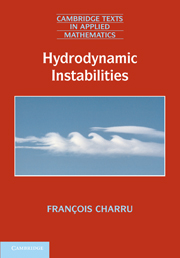Book contents
- Frontmatter
- Contents
- Foreword
- Preface
- Video resources
- 1 Introduction
- 2 Instabilities of fluids at rest
- 3 Stability of open flows: basic ideas
- 4 Inviscid instability of parallel flows
- 5 Viscous instability of parallel flows
- 6 Instabilities at low Reynolds number
- 7 Avalanches, ripples, and dunes
- 8 Nonlinear dynamics of systems with few degrees of freedom
- 9 Nonlinear dispersive waves
- 10 Nonlinear dynamics of dissipative systems
- 11 Dynamical systems and bifurcations
- Appendix A The Saint-Venant equations
- References
- Index
Foreword
Published online by Cambridge University Press: 05 August 2011
- Frontmatter
- Contents
- Foreword
- Preface
- Video resources
- 1 Introduction
- 2 Instabilities of fluids at rest
- 3 Stability of open flows: basic ideas
- 4 Inviscid instability of parallel flows
- 5 Viscous instability of parallel flows
- 6 Instabilities at low Reynolds number
- 7 Avalanches, ripples, and dunes
- 8 Nonlinear dynamics of systems with few degrees of freedom
- 9 Nonlinear dispersive waves
- 10 Nonlinear dynamics of dissipative systems
- 11 Dynamical systems and bifurcations
- Appendix A The Saint-Venant equations
- References
- Index
Summary
Hydrodynamic instabilities occupy a special position in fluid mechanics. Since the time of Osborne Reynolds and G. I. Taylor, it has been known that the transition from laminar flow to turbulence is due to the instability of the laminar state to certain classes of perturbations, both infinitesimal and of finite amplitude. This paradigm was first displayed in a masterful way in the studies of G. I. Taylor on the instability of Couette flow generated by the differential rotation of two coaxial cylinders. From then on, the theory of hydrodynamical instability has formed a part of the arsenal of techniques available to the researcher in fluid mechanics for studying transitions in a wide variety of flows in mechanical engineering, chemical engineering, aerodynamics, and in natural phenomena (climatology, meteorology, and geophysics).
The literature on this subject is so vast that very few researchers have attempted to write a pedagogical text which describes the major developments in the field. Owing to the enormity of the task, there is a temptation to cover a large number of physical situations at the risk of repetition and of wearying the reader with just a series of methodological approaches. François Charru has managed to avoid this hazard and has risen to the challenge. With this book he fills the gap between the classical texts of Chandrasekhar and Drazin and Reid, and the more recent book of Schmid and Henningson.
Classical instability theory essentially deals with quasi-parallel or parallel shear flows such as mixing layers, jets, wakes, Poiseuille flow in a channel, boundary-layer flow, and so on.
- Type
- Chapter
- Information
- Hydrodynamic Instabilities , pp. x - xiiPublisher: Cambridge University PressPrint publication year: 2011
- 2
- Cited by



